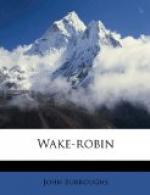The warblers are, perhaps, the most puzzling. These are the true Sylvia, the real wood-birds. They are small, very active, but feeble songsters, and, to be seen, must be sought for. In passing through the woods, most persons have a vague consciousness of slight chirping, semi-musical sounds in the trees overhead. In most cases these sounds proceed from the warblers. Throughout the Middle and Eastern States, half a dozen species or so may be found in almost every locality, as the redstart, the Maryland yellow-throat, the yellow warbler (not the common goldfinch, with black cap, and black wings and tail), the hooded warbler, the black and white creeping warbler; or others, according to the locality and the character of the woods. In pine or hemlock woods, one species may predominate; in maple or oak woods, or in mountainous districts, another. The subdivisions of ground warblers, the most common members of which are the Maryland yellow-throat, the Kentucky warbler, and the mourning ground warbler, are usually found in low, wet, bushy, or half-open woods, often on and always near the ground. The summer yellowbird, or yellow warbler, is not now a wood-bird at all, being found in orchards and parks, and along streams and in the trees of villages and cities.
As we go north the number of warblers increases, till, in the northern part of New England, and in the Canadas, as many as ten or twelve varieties may be found breeding in June. Audubon found the black-poll warbler breeding in Labrador, and congratulates himself on being the first white man who had ever seen its nest. When these warblers pass north in May, they seem to go singly or in pairs, and their black caps and striped coats show conspicuously. When they return in September they are in troops or loose flocks, are of a uniform dull drab or brindlish color, and are very fat. They scour the treetops for a few days, almost eluding the eye by their quick movements, and are gone.
According to my own observation, the number of species of warblers which one living in the middle districts sees, on their return in the fall, is very small compared with the number he may observe migrating north in the spring.
The yellow-rumped warblers are the most noticeable of all in Autumn. They come about the streets and garden, and seem especially drawn to dry, leafless trees. They dart spitefully about, uttering a sharp chirp. In Washington I have seen them in the outskirts all winter.
Audubon figures and describes over forty different warblers. More recent writers have divided and subdivided the group very much, giving new names to new classifications. But this part is of interest and value only to the professional ornithologist.
The finest songster among the Sylvia, according to my notions, is the black-throated greenback. Its song is sweet and clear, but brief.
The rarest of the species are Swainson’s warbler, said to be disappearing; the cerulean warbler, said to be abundant about Niagara; and the mourning ground warbler, which I have found breeding about the head-waters of the Delaware, in New York.




